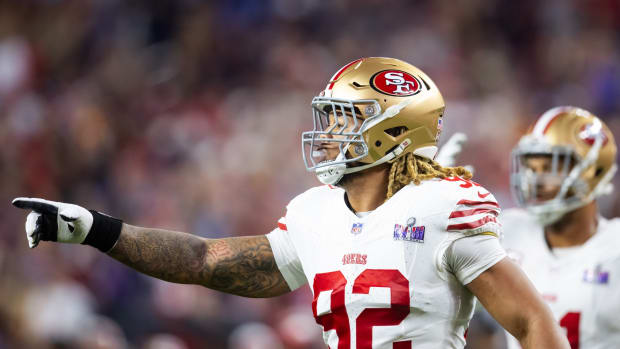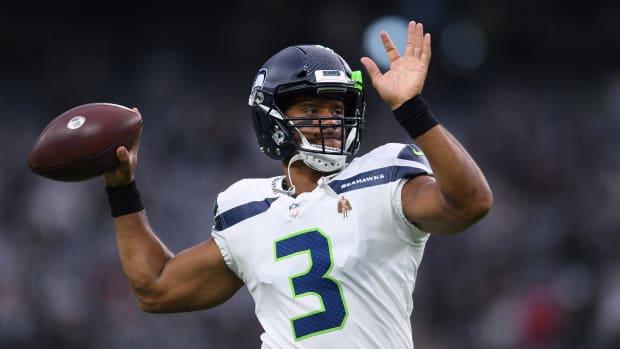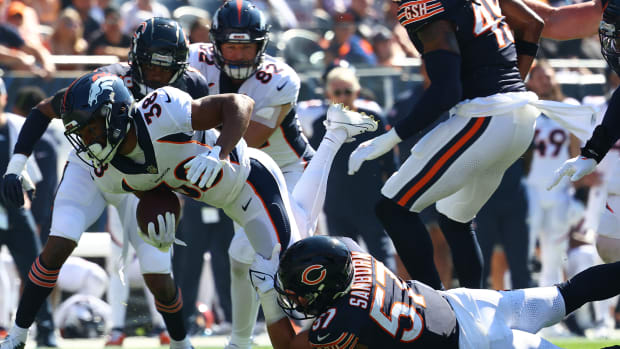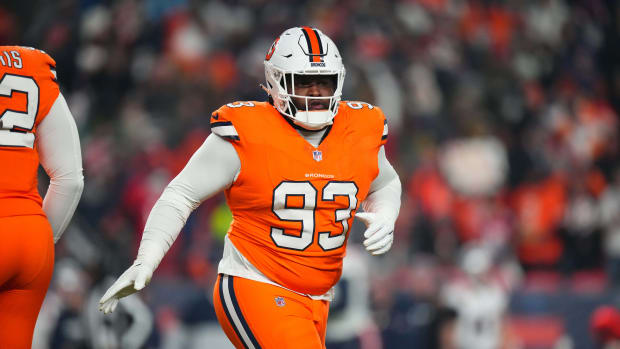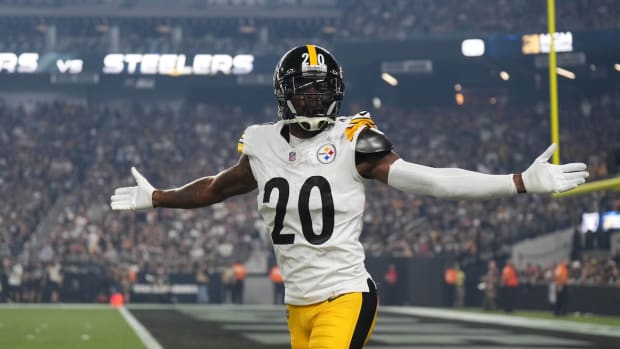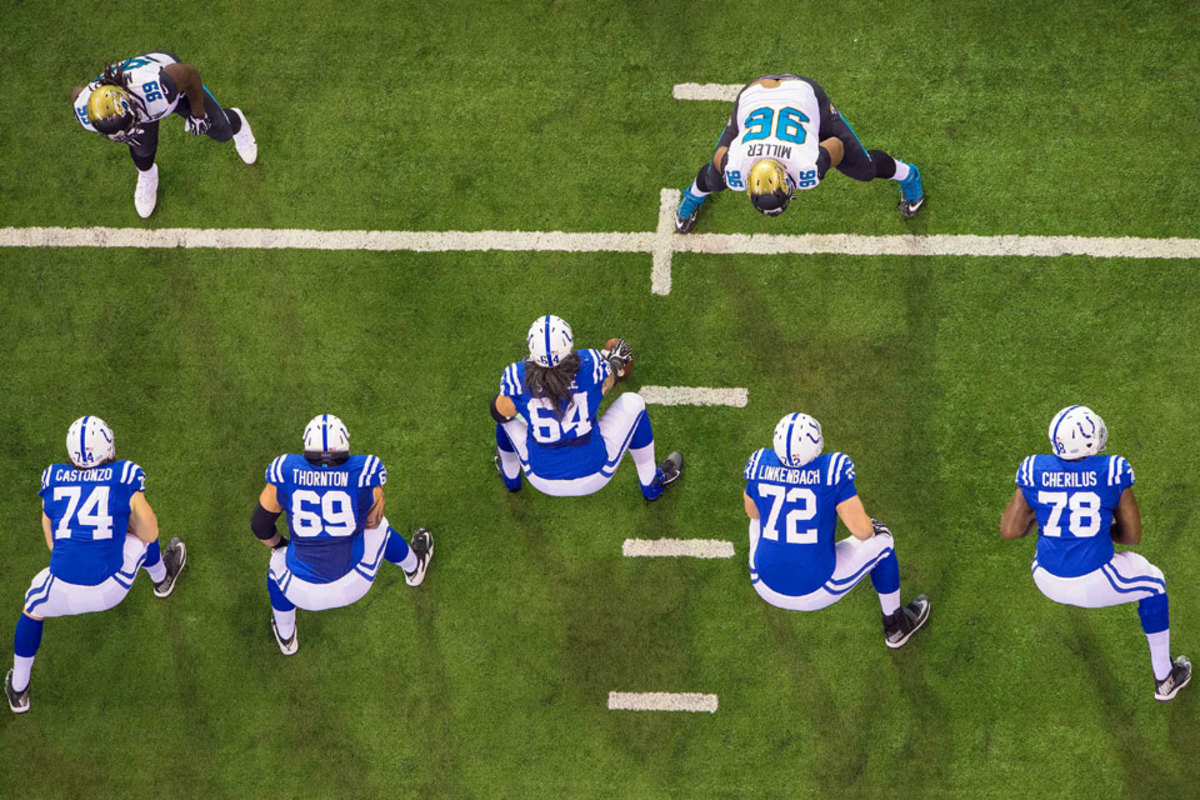
Measuring Beyond Girth
By Ross Tucker
Offensive linemen are football’s forgotten men. They sometimes work on an island, trying to stop rabid pass rushers one-on-one, while other times they’re cogs in complex schemes that demand perfect spacing and precision timing. No matter the assignment, they always toil in anonymity—unless, of course, they make a glaring mistake.
Aside from punters, offensive linemen are the only ones who aren’t represented in fantasy football. In real life, their performance is typically gauged by negative metrics: sacks allowed and penalties committed. Formulas such as the New York Life Protection Index and The MMQB’s Pressure Points depict how an entire line is playing, but there’s no sortable ranking on any mainstream pro football website that gives you a snapshot of, say, how a team’s right guard is playing.
But what if I told you that the only players who lack relevant statistics are actually the most scrutinized and harshly graded players on the field? And what if I told you that most front office executives and scouts typically know less about offensive line play than any other position? It’s a scary thought for veteran free agents such as Willie Colon, who spent his first seven seasons in Pittsburgh before joining the Jets in 2013.
A tackle turned guard, the soon-to-be 31-year-old ranks No. 78 on The MMQB’s list of top free agents. But in the absence of yards gained, passes caught or touchdowns scored, how do you measure the true value of a 6-foot-3, 350-behemoth who is paid to mimic a road grader?
All offensive linemen have stats, but they’re largely a matter of interpretation. Like pop quizzes taken in a classroom, the grades are often reflected in percentages, such as 82% or 93%. Although variations exist across all 32 teams, the gist is simple: a lineman gets a plus (+) for completing his assignment and a minus (-) when he fails. If a team runs 100 plays and a lineman gets 90 plusses his mark will be 90%—a solid game.
The cumulative score, for good or for worse, becomes a player’s identity.
“We only get tested, so to speak, 16 times,” says Eric Winston, a veteran tackle who enters free agency after playing with the Cardinals last season. “Those grades are your one and only report card.”
Yet there’s a fine line between living in the penthouse or the outhouse. An All-Pro grades between 89-93% while an average player grades between 85-89%. Dip below 85% and you’re staring at a career change. Let that sink in: The difference between making $5-10 million a year and going back to your hometown comes down to just a few plays a game. Those fate-deciding plays could be significant or they could be inconsequential—that’s how unforgiving the sport is—or your future could be determined by your opponent. If you’re going up against J.J. Watt one week, you’ll likely grade lower than your teammates. Catch a string a stars and, well, people may soon be questioning your ability to play in the NFL.
For veterans, it’s an increasing doubt they have to overcome with each passing offseason.
* * *
In November, I sat down with Colon at the Jets’ training facility in Florham Park, N.J., to watch game film and talk about how offensive linemen are graded. Colon, who had three offensive line coaches during his time with the Steelers, explained that his new coach, Mike Devlin, has a unique grading system in which players get a number (0-4) for each play.
Getting a 0 means you made an egregious mental error or a penalty. A 1 means a bad block. A 2 means you blocked your man but your technique left something to be desired. A 3 is given for executing your assignment with excellent technique. A 4? Well, that's a rarity. It means you got a 3 and then some, which likely means a pancake block. If you’re getting a lot of pancakes, you’re either going to the Hall of Fame—think former Cowboys guard Larry Allen—or the defender on the receiving end is going to hit the waiver wire by Tuesday.
Jets tackle Austin Howard (77) and guard Willie Colon executed a perfect “squeeze” block against the Falcons in Week 5. (Duncan Williams/Cal Sports Agency)
Colon and I watched the Jets’ Week 5 Monday Night Football victory over the Falcons. After playing college football at Princeton, I was a guard for the Redskins, Cowboys, Bills and Patriots from 2001-07, so I figured I might as well go over a good grade sheet with one of my big-men brethren, right?
Colon highlighted a play early in the first quarter on which he got a 3 because he and right tackle Austin Howard executed a unique mental assignment to perfection. The call was scat protection, meaning there was no back in the backfield to protect rookie QB Geno Smith. When the Falcons blitzed, Colon and Howard had to “squeeze” the inside gaps. Colon picked up the blitzing linebacker to his inside, and Howard took the defensive tackle who had lined up over Colon, leaving the edge rusher free but giving Smith enough time to throw the ball.
Late in the second quarter, Colon received a 1 because he didn’t give center Nick Mangold enough help on the defensive tackle before moving on to block a linebacker on the second level. Even worse, he tripped and his man made the tackle. But a few plays later he redeemed himself with a 4. On a lead draw to the weak side, Colon and Mangold knocked defensive tackle Peria Jerry back a full seven yards—into the linebacker—to spring running back Bilal Powell. It’s among the rarest, most successful blocks you’ll ever see.
Finally, it’s crunch time. The Jets are trailing, 28-27, and trying to get into field goal range with less than a minute to play. Powell runs directly behind Colon, who knocks Corey Peters, a 305-pound defensive tackle, a yard off the ball on a solo drive block, which is very hard to do. Powell gets the first down, Colon gets a 3, and a few plays later Nick Folk kicks the winning field goal. Linemen don’t make headlines, but at least Rex Ryan recognized Colon and Mangold by giving them game balls for their efforts.
Though the Jets were triumphant and Colon’s contributions were heralded, his line coach still went through the tedious task of grading every play before preparing for the next opponent.
* * *
Most coaches grade performance and technique, which have a strong correlation but not always. For example, a lineman might get a plus (+) for blocking his man but a simultaneous minus (-) because he didn’t take the right footwork. The goal is to get as many +/+ plays as possible and avoid -/- like the plague. Some coaches factor in the difficulty of the opponent, but grades aren’t a pure barometer of talent. Grading offensive linemen is actually an inexact science that can be as subjective as art.
The idea is to give an objective evaluation of each player's performance, but there’s no doubt in my mind that some line coaches whom I played for had a grading bias. It’s impossible to know whether biases are conscious or subconscious; sometimes a coach has an affinity for a certain player because he recommended drafting or signing him. The opposite can hold true. If a coach doesn't like you because you aren’t “his guy”—well, you shouldn't expect any benefit of the doubt.
Cardinals right tackle Eric Winston (73) picks himself up after making one cut block to take on a Bucs linebacker. (Al Tielemans/SI/The MMQB)
“There's no question that it is somewhat subjective,” Winston says. “These are human beings giving out the grades. How could it not be?”
I saw numerous examples over the years when one player would get a plus in almost the exact same situation that another would get a minus. There can be a gray area based on how important the technique component is, but the more I thought about it, the more I wondered if I had once benefitted from such bias.
In 2002, I started the last seven games at left guard in place of an injured Allen for the Cowboys, who claimed me off waivers midway through the season after the Redskins cut me. I finished with the highest grade among all linemen in six of those games. At the time, I was 23 and playing fairly well, so I didn't think much of it. In college, I sometimes thought I was getting somewhat of a raw deal compared to a couple of my teammates’ grades. But as a second-year pro, I believed linemen’s grades to be sacred in the NFL. It never occurred to me that I could be benefiting from bias.
The guys whom I played alongside, Flozell Adams and Andre Gurode, went on to multiple Pro Bowls and had much better careers than I did. Could I have really outperformed them? Gurode was only a rookie and had been playing right guard, opposed to center, the position at which he made the Pro Bowl. It wasn’t a career-defining stretch of games for Adams, but there was only one way to find out: I called Frank Verducci, my line coach in Dallas who in 2013 oversaw the offensive line for the Montreal Alouettes in the CFL.
“Frank,” I asked point-blank, “are you sure I deserved to grade out the highest in those games?”
“Absolutely,” he responded, “You were the most productive guy we had.”
“There’s no question that winning and losing affect my objectivity,” Jets line coach Mike Devlin says. “It certainly affects my mood when doing the grades.”
He went on to explain that a plus is a plus and a minus is a minus—although he mentioned something else that made me think I had received help on more than one occasion. Verducci’s grading system placed a premium on knocking opponents off their feet, a specialty of mine. Any cut block that sent a defender to the turf was given extra credit, if you will. After watching film with Colon, I asked Mike Devlin, the Jets’ line coach, if bias exists. “There’s no question that winning and losing affect my objectivity,” he said. “It certainly affects my mood when doing the grades, and that has to have an impact somehow.”
I pressed for more details from Verducci, who said, “You have to understand that a line coach has a vision of what he wants his line to look like. When you’re up until 2 a.m. grading, you do appreciate the guys who are trying to do things in line with that vision.” Then he added: “If we had five guys like you, we wouldn't have won a Super Bowl—but we would've been in every game."
Thanks! I think?
Pro Football Focus ranks players, by all positions, based on proprietary formulas. Agents are now using the information to leverage contract negotiations.
Unlike my time in the NFL, teams aren’t the only ones grading offensive linemen. The analytics website ProFootballFocus.com rates them as well. According to PFF, Colon tied for 36th overall among guards in 2013. But the stats are so detailed that Colon’s agent can parse them to find leverage. In a bygone era of football, teams might have been able to point at Colon’s 12 penalties—the most among guards in the league—and call them a red flag. But the agent can counter that Colon ranked fourth among guards in pass protection, and first among available free agents this offseason.
But just like coaches’ grades, the PFF marks aren’t perfect. Though there’s no bias, there’s a lack of insight.
“The only people who know whether a player screwed up are the guys in that meeting room,” allows Sam Monson, a Pro Football Focus analyst. “We try to counter that by only grading what a player attempts to do, rather than guessing what he was supposed to do.”
Says Winston, who is No. 69 on the PFF ranking of 2013 tackles: “It's very hard to do it independently. Last season was my eighth year and I still can't always tell who messed up when watching film of other teams.”
Grading linemen can hold players accountable, and it can get everyone on the same page in terms of expectations, but doing so is not without peril.
“I don't like when guys get too grade-conscious,” Devlin says. “Sometimes you just have to block the freakin’ guy.”
* * *
But how can you not be grade-conscious when so much is at stake? “Line coaches will downplay it sometimes,” Winston says, “but you know that everyone in the organization is seeing those grades.”
He's right. I've seen more than one line coach claim he was the only one looking at grades, but then those grades were introduced during contract negotiations. It’s why some veterans bristle at being graded, believing it to be a flawed and an unnecessary exercise.
Colon celebrating the Steelers’ Super Bowl XLIII victory in February 2009. (Damian Strohmeyer/SI/The MMQB)
Willie Colon, however, isn't one of those veterans.
“In Pittsburgh, we would always say that your tape is your résumé,” he says, “and the grades are a reflection of your tape.”
Winston, who spent his first six seasons in Houston before spending the last two in Kansas City and Arizona, finds value in being graded—to a certain point. “The grade itself isn't as important as the feedback that you get going through and reviewing the grading process,” he says.
Teams, I believe, do a decent job of understanding how opponents can affect a lineman's grade in a given week. But there’s a knowledge gap in assessing the different line positions over an entire season. You might recall, for instance, left guards getting huge contracts in 2007. Derrick Dockery and Eric Steinbach were solid players, but neither was worthy of the 7 year, $49 million deals they both inked. Yet they were highly sought after because they graded out so well when other teams did their own evaluations.
The reality is, most left guards should grade out higher than right guards.
Most teams are “right-handed,” meaning they often put the strength of the offensive formation to the right side rather than the left. As a result, most slide protections—a zone scheme in which three linemen block two defenders—go to the left, which is customarily the quarterback's blindside. This means the right guard on most teams has a tougher job because he’s tasked with more one-on-one pass blocking assignments than the left guard. The stats bear this out: In the Pro Football Focus rankings of guards who played at least half of their team’s snaps last season, seven of the top 11 were left guards; 12 of the top 15 tackles also played on the left side.
Until sites like Pro Football Focus become mainstream, the pervading belief will be that you can only tell how an offensive line is playing based on sacks allowed or rushing yards per carry—flawed metrics that suggest you can have a forest without any trees. Whether an offense moves the ball forward and gets pushed backward, football’s forgotten big men are playing a game in which their personal scoreboards change on every play like a stock market ticker.
As someone who started at least five NFL games at both guard positions, I often tell people that I could have played left guard for an entire season and the team would have been fine. Right guard? I would have been exposed as a liability after a handful of games because my one-on-one pass protection wasn't up to snuff. Then again, you’d never know it by looking at my 2002 grades.
Can someone please show me the dotted line?
A former NFL offensive lineman, Ross Tucker is a national columnist for the Sporting News.





































